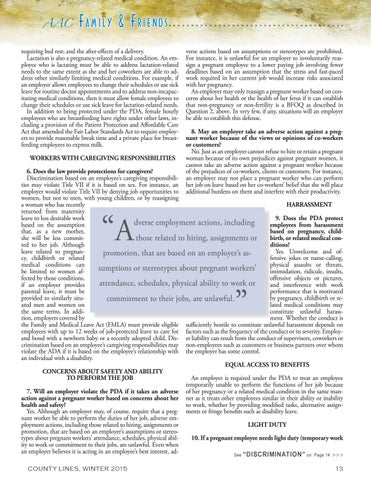AAC
Family & Friends
» » » » » » » » » » » » » » » » » » » » » » » » » » » » » » » » » » » » » » »
requiring bed rest; and the after-effects of a delivery. Lactation is also a pregnancy-related medical condition. An employee who is lactating must be able to address lactation-related needs to the same extent as she and her coworkers are able to address other similarly limiting medical conditions. For example, if an employer allows employees to change their schedules or use sick leave for routine doctor appointments and to address non-incapacitating medical conditions, then it must allow female employees to change their schedules or use sick leave for lactation-related needs. In addition to being protected under the PDA, female hourly employees who are breastfeeding have rights under other laws, including a provision of the Patient Protection and Affordable Care Act that amended the Fair Labor Standards Act to require employers to provide reasonable break time and a private place for breastfeeding employees to express milk. WORKERS WITH CAREGIVING RESPONSIBILITIES
verse actions based on assumptions or stereotypes are prohibited. For instance, it is unlawful for an employer to involuntarily reassign a pregnant employee to a lower paying job involving fewer deadlines based on an assumption that the stress and fast-paced work required in her current job would increase risks associated with her pregnancy. An employer may only reassign a pregnant worker based on concerns about her health or the health of her fetus if it can establish that non-pregnancy or non-fertility is a BFOQ as described in Question 2, above. In very few, if any, situations will an employer be able to establish this defense. 8. May an employer take an adverse action against a pregnant worker because of the views or opinions of co-workers or customers? No. Just as an employer cannot refuse to hire or retain a pregnant woman because of its own prejudices against pregnant women, it cannot take an adverse action against a pregnant worker because of the prejudices of co-workers, clients or customers. For instance, an employer may not place a pregnant worker who can perform her job on leave based on her co-workers’ belief that she will place additional burdens on them and interfere with their productivity.
6. Does the law provide protections for caregivers? Discrimination based on an employee’s caregiving responsibilities may violate Title VII if it is based on sex. For instance, an employer would violate Title VII by denying job opportunities to women, but not to men, with young children, or by reassigning a woman who has recently HARRASSMENT returned from maternity leave to less desirable work 9. Does the PDA protect dverse employment actions, including based on the assumption employees from harassment that, as a new mother, based on pregnancy, childshe will be less commitbirth, or related medical conthose related to hiring, assignments or ted to her job. Although ditions? leave related to pregnanYes. Unwelcome and ofpromotion, that are based on an employer’s ascy, childbirth or related fensive jokes or name-calling, medical conditions can physical assaults or threats, sumptions or stereotypes about pregnant workers’ be limited to women afintimidation, ridicule, insults, fected by those conditions, offensive objects or pictures, attendance, schedules, physical ability to work or if an employer provides and interference with work parental leave, it must be performance that is motivated provided to similarly situby pregnancy, childbirth or recommitment to their jobs, are unlawful. ated men and women on lated medical conditions may the same terms. In addiconstitute unlawful harasstion, employers covered by ment. Whether the conduct is the Family and Medical Leave Act (FMLA) must provide eligible sufficiently hostile to constitute unlawful harassment depends on employees with up to 12 weeks of job-protected leave to care for factors such as the frequency of the conduct or its severity. Employand bond with a newborn baby or a recently adopted child. Dis- er liability can result from the conduct of supervisors, coworkers or crimination based on an employee’s caregiving responsibilities may non-employees such as customers or business partners over whom violate the ADA if it is based on the employee’s relationship with the employer has some control. an individual with a disability. EQUAL ACCESS TO BENEFITS CONCERNS ABOUT SAFETY AND ABILITY TO PERFORM THE JOB An employer is required under the PDA to treat an employee temporarily unable to perform the functions of her job because 7. Will an employer violate the PDA if it takes an adverse of her pregnancy or a related medical condition in the same manaction against a pregnant worker based on concerns about her ner as it treats other employees similar in their ability or inability health and safety? to work, whether by providing modified tasks, alternative assignYes. Although an employer may, of course, require that a preg- ments or fringe benefits such as disability leave. nant worker be able to perform the duties of her job, adverse employment actions, including those related to hiring, assignments or LIGHT DUTY promotion, that are based on an employer’s assumptions or stereotypes about pregnant workers’ attendance, schedules, physical abil10. If a pregnant employee needs light duty (temporary work ity to work or commitment to their jobs, are unlawful. Even when an employer believes it is acting in an employee’s best interest, adSee “DISCRIMINATION” on Page 14 > > >
“A
”
COUNTY LINES, WINTER 2015
13




